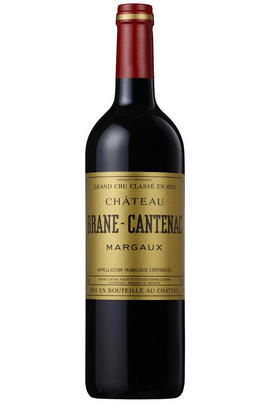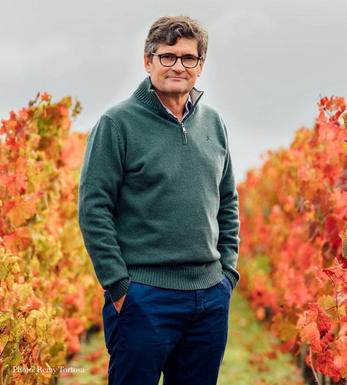
2005 Château Brane-Cantenac, Margaux, Bordeaux

Critics reviews
The 2005 Brane-Cantenac, which was picked from September 17 to October 10, has a suave, elegant bouquet of blackberry, cedar, gravel and tobacco scents, certainly showing more intensity and energy than any of the last five vintages. The palate is medium-bodied with fine and surprisingly supple tannins that are finally beginning to soften. I love the freshness here, and the wine is less of a curmudgeon than I rudely asserted in the past. It is beginning to loosen its tie, and as such, it’s a vintage to keep an eye on. Tasted at the Brane-Cantenac vertical at the château.
Drink 2020 - 2045
Neal Martin, Vinous.com (January 2019)
The 2005 Brane-Cantenac is fabulous. Effusive and explosive to the core, the 2005 possesses tons of energy and pedigree to burn. Crushed flowers, mint, gravel, red/purplish fruit, sage and mocha abound. In 2005, Brane-Cantenac is remarkably deep and vivid. It also comes across as needing a bit more time to soften. Readers will find one of the most distinguished wines of the Left Bank. I especially admire its drive and mid-weight classicism. Hints of cedar and sweet pipe tobacco linger.
Drink 2025 - 2045
Antonio Galloni, Vinous.com (April 2021)
I have loved this wine on many occasions, and I love it here again. This is not a wine that is hiding its age - there are already some tertiary notes developing - and you'll find younger-looking 2005s, but it has a generosity of spirit, a succulence to its fruit, and a hauntingly fresh menthol edge to the finish that is really beautiful. Mouthwatering brilliance. 45% of production.
Drink 2018 - 2030
Jane Anson, Decanter.com (November 2017)
A sexy style of wine from the Lurtons at Brane-Cantenac, this wine (a blend of 51% Cabernet Sauvignon, 41% Merlot and the rest Cabernet Franc) has a stunning nose of forest floor, liquorice, blackcurrants, plums and spring flowers. Soft tannin, full-bodied opulence and beautifully textured, lush richness make for a brilliant wine from this large, 180-acre vineyard. In spite of the wine’s stunning forward fragrance and lushness, the colour still looks as if it is 3-4 years old rather than a decade. This is a big-time winner in 2005, and should drink well for at least another 25+ years.
Drink 2015 - 2040
Robert M. Parker, Jr., Wine Advocate (June 2015)
With its classic Left Bank profile, this blend of 51% Cabernet and 43% Merlot along with 8% Cabernet Franc aged in 70% new casks opened with a bit of tomato and some slightly herbal notes initially but gradually developed aromas of redcurrant, bright cherries, and spice. The texture on the palate was dense and tannic, pointing to a promise of future development—surprisingly good value.
Drink 2021 - 2040
Charles Curtis, Decanter.com (June 2021)
Good bright red-ruby. Subdued but pure aromas of currant, dark chocolate and sexy oak. Moderately sweet, medium-bodied and vinous, with ripe acidity and a floral element providing mid-palate lift. It is still a bit medicinal and unevolved, but it has the serious structure to develop slowly and well in bottle. Finishes long and firm.
Stephen Tanzer, Vinous.com (May 2008)
About this WINE

Chateau Brane-Cantenac
Château Brane-Cantenac was for many years the home of Lucien Lurton - it is now owned and run by his son Henri. Its vineyards are located west of the village of Cantenac in the Margaux appellation. Brane-Cantenac's vineyards are planted with Cabernet Sauvignon (55%), Merlot (40%), Cabernet Franc (4.5%) and Carmenère 0,5%, and lie on fine, gravelly soils. Vinification includes up to 18 months' wood ageing, a third to a half in new `barriques'.
Brane Cantenac was perceived throughout much of the 70s and 80s as an underperforming property. Since Henri took over, there has been extensive investment in the cuverie and chai, as well as vastly improved vineyard management techniques. Consequently, the wines at Brane Cantenac now show more weight and concentration, although they still possess that haunting bouquet and quintessential elegance that characterise the wines of Margaux. It is classified as a 2ème Cru Classé.

Margaux
If Pauillac can be seen as the bastion of ‘traditional’ Red Bordeaux, then Margaux represents its other facet in producing wines that are among Bordeaux’s most sensual and alluring. It is the largest commune in the Médoc, encompassing the communes of Cantenac, Soussans, Arsac and Labaude, in addition to Margaux itself. Located in the centre of the Haut-Médoc, Margaux is the closest of the important communes to the city of Bordeaux.
The soils in Margaux are the lightest and most gravelly of the Médoc, with some also containing a high percentage of sand. Vineyards located in Cantenac and Margaux make up the core of the appelation with the best vineyard sites being located on well-drained slopes, whose lighter soils give Margaux its deft touch and silky perfumes. Further away from the water, there is a greater clay content and the wines are less dramatically perfumed.
Margaux is the most diffuse of all the Médoc appelations with a reputation for scaling the heights with irreproachable wines such as Ch. Margaux and Ch. Palmer, but also plumbing the depths, with too many other châteaux not fulfilling their potential. There has been an upward shift in recent years, but the appellation cannot yet boast the reliability of St Julien. However, the finest Margaux are exquisitely perfumed and models of refinement and subtlety which have few parallels in Bordeaux.
Recommended Châteaux: Ch. Margaux, Ch. Palmer, Ch. Brane-Cantenac, Ch. Rauzan-Ségla , Ch. Dufort-Vivens, Ch. Ferrière, Ch. du Tertre, Ch. Giscours, Ch. d'Angludet.

Cabernet Sauvignon Blend
Cabernet Sauvignon lends itself particularly well in blends with Merlot. This is actually the archetypal Bordeaux blend, though in different proportions in the sub-regions and sometimes topped up with Cabernet Franc, Malbec, and Petit Verdot.
In the Médoc and Graves the percentage of Cabernet Sauvignon in the blend can range from 95% (Mouton-Rothschild) to as low as 40%. It is particularly suited to the dry, warm, free- draining, gravel-rich soils and is responsible for the redolent cassis characteristics as well as the depth of colour, tannic structure and pronounced acidity of Médoc wines. However 100% Cabernet Sauvignon wines can be slightly hollow-tasting in the middle palate and Merlot with its generous, fleshy fruit flavours acts as a perfect foil by filling in this cavity.
In St-Emilion and Pomerol, the blends are Merlot dominated as Cabernet Sauvignon can struggle to ripen there - when it is included, it adds structure and body to the wine. Sassicaia is the most famous Bordeaux blend in Italy and has spawned many imitations, whereby the blend is now firmly established in the New World and particularly in California and Australia.


Buying options
Add to wishlist
Description
The 2005 Brane-Cantenac, which was picked from September 17 to October 10, has a suave, elegant bouquet of blackberry, cedar, gravel and tobacco scents, certainly showing more intensity and energy than any of the last five vintages. The palate is medium-bodied with fine and surprisingly supple tannins that are finally beginning to soften. I love the freshness here, and the wine is less of a curmudgeon than I rudely asserted in the past. It is beginning to loosen its tie, and as such, it’s a vintage to keep an eye on. Tasted at the Brane-Cantenac vertical at the château.
Drink 2020 - 2045
Neal Martin, Vinous.com (January 2019)
wine at a glance
Delivery and quality guarantee